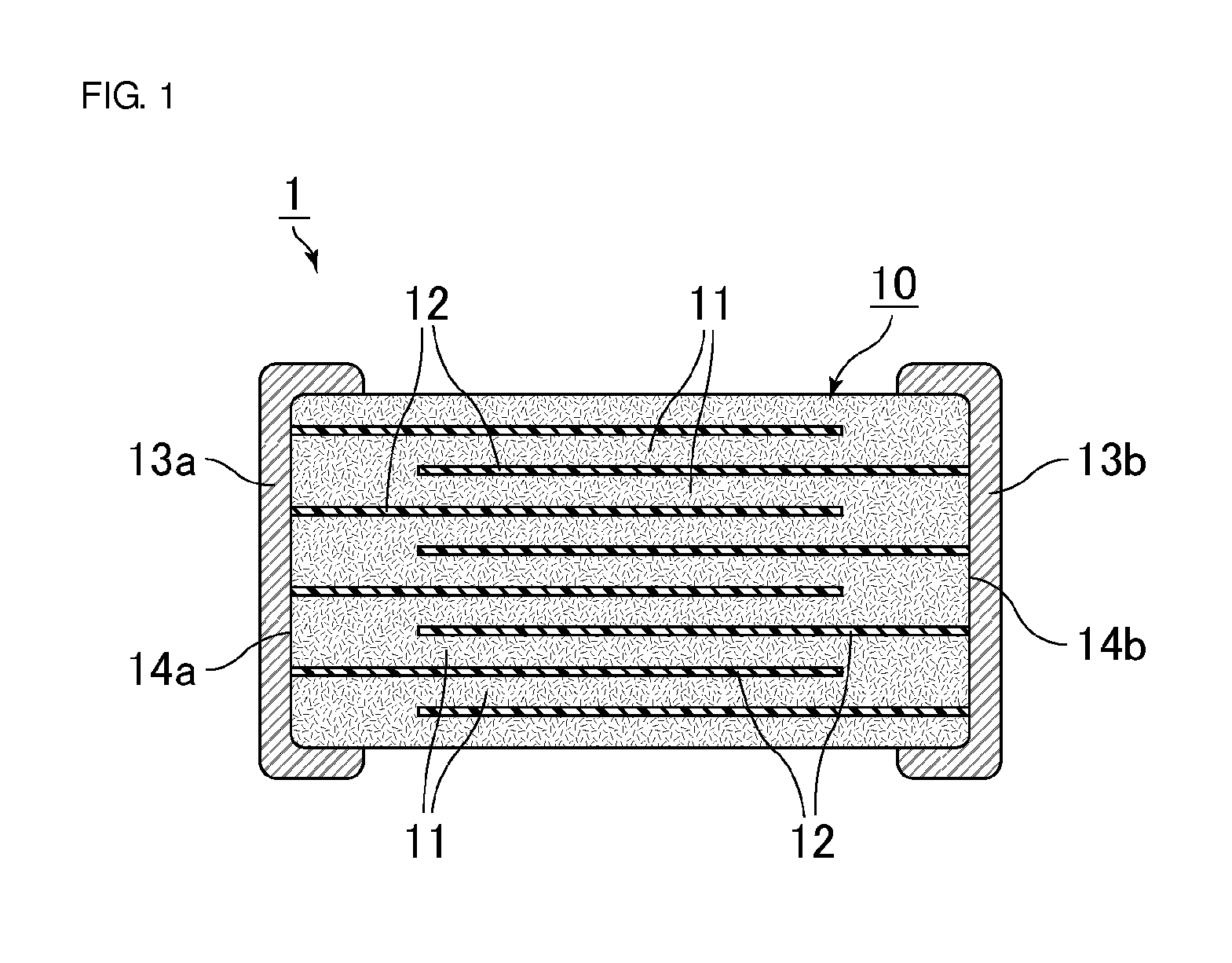Multilayer ceramic capacitor and method for producing multilayer ceramic capacitor
a multi-layer ceramic capacitor and ceramic capacitor technology, applied in the direction of fixed capacitors, fixed capacitor electrodes, electrical equipment, etc., can solve the problems affecting the overall reliability of multi-layer ceramic capacitors, and achieve the effect of effectively preventing the movement of oxygen vacancies
- Summary
- Abstract
- Description
- Claims
- Application Information
AI Technical Summary
Benefits of technology
Problems solved by technology
Method used
Image
Examples
examples
[0123]The following describes some examples that disclose multilayer ceramic capacitors according to a preferred embodiment of the present invention in more detail. Note that these examples are not the only possible forms of various preferred embodiments of the present invention.
examples 1-1 to 1-15
and Comparative Examples 1-1 to 1-11
A) Preparation of a Ceramic Raw Material
[0124]Predetermined amounts of BaCO3 and TiO2 as starting materials were mixed using a ball mill. The mixture was heated at approximately 1150° C., yielding a perovskite compound Ba1.0070TiO3. The average particle diameter was approximately 0.15 μm, and the Ba / Ti ratio was approximately 1.0070.
[0125]The obtained Ba1.0070TiO3 (hereinafter also referred to as BT) was mixed with additional components for the Example or Comparative Example using a ball mill in accordance with the mixing formula in Table 1. The resulting mixture was dried, yielding a ceramic raw material.
[0126]The additional components were added in the form of CaCO3, MgO, R2O3, an oxide of M, and SiO2.
[0127]For use as the R2O3, powders of the following compounds were prepared: La2O3, Pr2O3, Eu2O3, Ho2O3, Er2O3, Lu2O3, Ce2O3, Yb2O3TM2O3, Tb2O3, Gd2O3, SM2O3, Nd2O3, Y2O3, and Dy2O3.
[0128]ICP analysis was performed on the obtained ceramic raw mater...
examples 2-1 to 2-11
A) Preparation of a Ceramic Raw Material
B) Production of Multilayer Ceramic Capacitors
[0150]As in Example 1-1, the compound BT used in Example 1-1 was mixed with additional components for the Example in accordance with the mixing formula in Table 2, and the obtained ceramic raw material was used to produce multilayer ceramic capacitors.
[0151]Example 2-1, in which the R included only Dy, an R1 element, is equivalent to Example 1-15.
[0152]In Examples 2-2 to 2-9, two sources of R were used. All of these Examples used one R1 element and one R2 element, with the proportion in parts by mole of R1 set as high as at least approximately four times larger than that of R2 (R1 / R2 approximately 4).
[0153]In Example 2-10, the R included only Ce, an R2 element.
[0154]In Example 2-11, two sources of R were used. The proportions of Dy, an R1 element, and Ce, an R2 element, were set in such a manner that R1 / R2
[0155]For all of these Examples, ICP analysis was performed on the ceramic ra...
PUM
 Login to View More
Login to View More Abstract
Description
Claims
Application Information
 Login to View More
Login to View More - R&D
- Intellectual Property
- Life Sciences
- Materials
- Tech Scout
- Unparalleled Data Quality
- Higher Quality Content
- 60% Fewer Hallucinations
Browse by: Latest US Patents, China's latest patents, Technical Efficacy Thesaurus, Application Domain, Technology Topic, Popular Technical Reports.
© 2025 PatSnap. All rights reserved.Legal|Privacy policy|Modern Slavery Act Transparency Statement|Sitemap|About US| Contact US: help@patsnap.com


